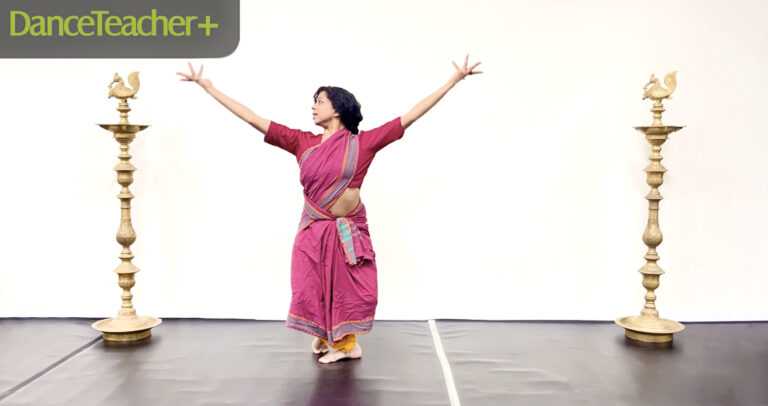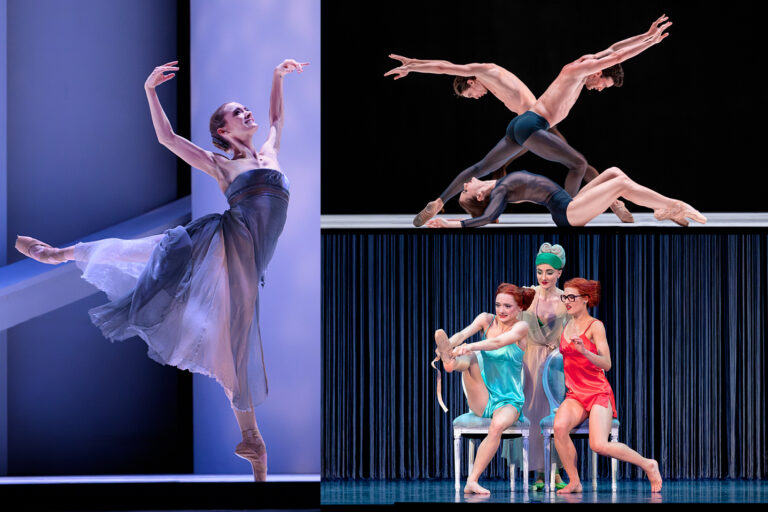Three students who discovered aerial—and how it’s impacting their dance careers
At UNH, students—like Kayla Lennon, pictured here—can perform up to 11 times a year.
Blair Davis hung 60 feet in the air, tethered by a rope and harness to one of the tallest buildings on campus at Washington and Lee University. No, she wasn’t trying a daredevil stunt. She was dancing, catapulting herself off the brick wall to extend her limbs to heights they’d never reached before. Aerial dance—movement that happens in the air on apparatuses like Davis’ rope and harness—is no longer solely for circus performers. It’s everywhere! Colleges, musical theater productions and even traditional “grounded” dance companies are getting in on the act. Here, three students explain how a college dance experience in aerial helped them develop new physical strengths and skills and opened up career pathways.
The Buff Ballerina
Davis didn’t arrive at W&L as an aerialist. She was a ballet student who fell in love with aerial during an intensive four-week course during her sophomore year. “Aerial gave me a new sense of fearlessness and trained me to use my body differently,” she says. “With the rope and harness, you have to engage your core incredibly to keep your body parallel to the ground, and you need to be able to climb up to the top of the fabric before you can do any tricks with silks.” Her physical control, honed from years of ballet, allowed her to quickly develop the necessary core and upper-body strength, but she struggled with not having mirrors for instant feedback. Getting used to a no-mirror zone enhanced her awareness of her body in space: “Aerial really helped develop my proprioception skills,” she says.
Beefing Up Her Resumé
Kayla Lennon discovered the University of New Hampshire’s aerial classes when her hometown dance teacher enrolled and brought the technique back to her studio. Lennon followed in his footsteps. “You can find ways to dance at any university,” she says, “but learning aerial in such a structured way is really rare.” Within its theater/dance BA, UNH offers an aerial class that spans experience levels: All students attend twice a week to work on basic technique, and advanced students come for an additional weekly workshop to learn accelerated movements. (Lennon’s favorite trick? Hanging by her ankles from the trapeze.) Students can perform 11 times a year (in end-of-semester showcases and site-specific or studio performances) and train on almost every apparatus available: silks, hoops, trapeze, Spanish web and nets. Lennon now teaches aerial classes at her home studio during the summer and plans to audition for aerial and dance shows when she graduates this spring. After seeing UNH alumni get cast in the Canadian run of the musical Pippin, which features aerial dance, she’s optimistic about the increased viability aerial skills will give her as a dance professional.
Tangential Tracks
Meghan Critchley wasn’t sure she wanted to major in dance. Discovering aerial changed her mind. “I hadn’t even heard of aerial until college,” she says. The University of Wyoming senior grew up studying ballet and jazz at a studio but fell in love with the freedom of vertical dance. “We’re so used to ‘technique, technique, technique,’” she says. “When I’m in the air, I’m more creative, more focused on new ways that I can move.” Of course, new movement brings new physical challenges. Critchley, who hopes to ultimately pursue physical therapy, says that although aerial decreases pressure on the limbs, certain apparatuses (like the harness) increase pressure on the lower spine. “As more dancers go into this field, figuring out how to keep them healthy will be a new frontier of research,” she says. DT
Julie Schechter is a dancer and New York City–based freelance writer.
Washington and Lee University offers a four-week aerial intensive.
Apparatus Primer
Bungee: two bungee loops suspended from the ceiling for the dancer to harness into
Hoop (also known as lyra): a steel hoop—resembling a hula hoop—hung from the ceiling
Net: crosshatch fabric arranged in a sling shape and hung from the ceiling
Rope and harness: a harness tethered to a vertical point via a rope
Silk: a long strip of fabric suspended from the ceiling at its center point
Spanish web: a rope wrapped in a cotton fabric covering and suspended at one end. At the top, a loop is attached to the rope for the performer to insert an ankle or wrist from which to hang.
Trapeze: one or more suspended horizontal bars with vertical lines attaching it to an overhead mount point
Where to Study Aerial Dance
East Tennessee State University
Johnson City, TN
Apparatuses: low-flying trapeze and silks
Facilities: aerial dance studio with eight silks and two low-flying trapeze
Performance opportunities: an aerial dance showcase at the end of each semester and a yearly main-stage dance concert
Degree offered: minor in dance (a major will potentially be implemented in fall 2017)
Aerial classes offered: three levels of aerial dance (beginner, intermediate, advanced)
University of Colorado at Boulder
Boulder, CO
Facilities: studio with rigging for six apparatuses
Apparatuses: low-flying trapeze and fabrics
Performance opportunities: up to six shows a year (concerts and informal showcases)
Degrees offered: BA and BFA with aerial coursework; MFA students can choose an aerial track as a secondary area of interest in their degree
Aerial classes offered: one technique class, though students can also take independent study at the nearby Frequent Fliers School and Company
University of New Hampshire
Durham, NH
Facilities: 22-foot ceilings in the studio; six stations where aerial dancers can work simultaneously
Apparatuses: silks, hoops, Spanish web, nets, trapeze
Performance opportunities: two end-of-semester shows and additional performances for community groups (in the aerial studio) and the student body (outside, on campus buildings)
Degrees offered: BA theater major with a dance option; dance minor
Aerial classes offered: one technique class, offered two days a week for beginners and three days a week for advanced students
University of Wyoming
Laramie, WY
Facilities: studio theater with rigging for 12 dancers
Apparatuses: rope and harness
Performance opportunities: one on-campus concert per year and an aerial show every other summer at Vedauwoo, a nearby wilderness area
Degree offered: BFA in dance performance or dance science
Aerial classes offered: two levels of technique class
Washington and Lee University
Lexington, VA
Facilities: dance studio rigged with six stations, with interchangeable apparatuses
Apparatuses: rope and harness, silks and bungee
Performance opportunities: fall (student-choreographed) and winter (faculty-choreographed) end-of-semester shows and a capstone showcase for the four-week spring aerial intensive
Degree offered: dance minor
Aerial classes offered: semester-long class during winter term and an intensive during spring term
Photo by Talia Pepin, courtesy of Lennon; opposite page: photo by Kevin Remington, courtesy of W&L University




